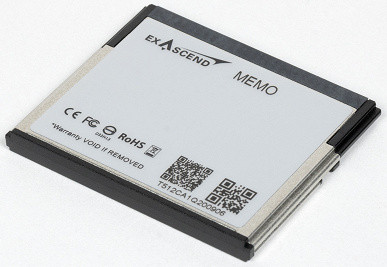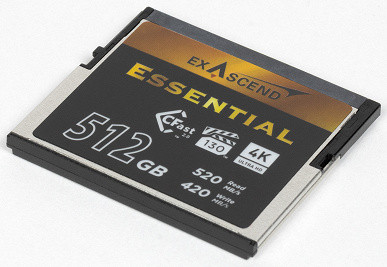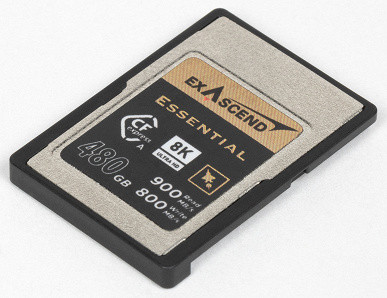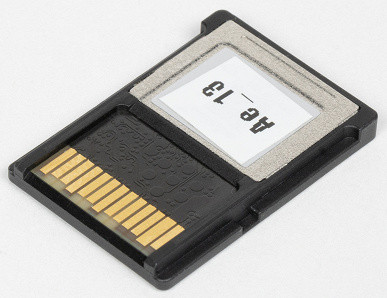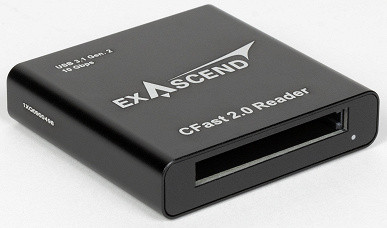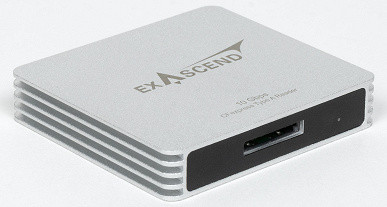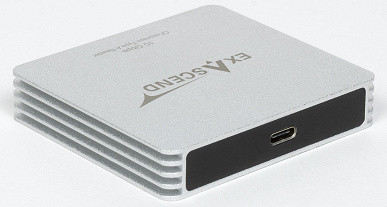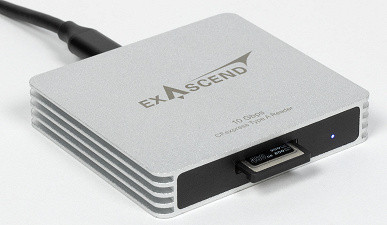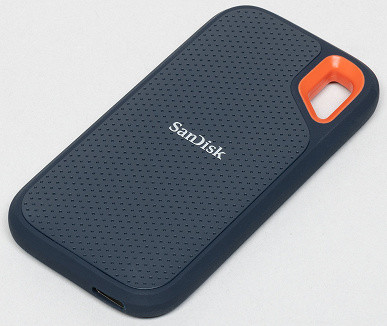CompactFlash (CF) has become an important memory card format that was developed 30 years ago. It has proven to be ideal for professional use due to its ability to accommodate large amounts of flash memory and provide high data transfer rates through parallel operation. Over time, it became obvious that the CF format had no worthy alternatives, and for a long time it remained the main choice for professionals and technology enthusiasts.
Unlike CF, its successors, such as CFast 2.0 and CFexpress 2.0, were not able to establish themselves in the market as successfully. However, these new formats represent a significant improvement in storage technology: CFast 2.0 and CFexpress 2.0 incorporate previous standards such as XQD and provide significant improvements in performance and capacity.
Compatibility with existing equipment and maintaining CF standards have been key advantages of the format over the years. The CF developers have accelerated the parallel interface several times, avoiding a complete transition to SATA and maintaining compatibility with legacy hardware. This decision maintained CF's dominance in the professional and semi-pro market.
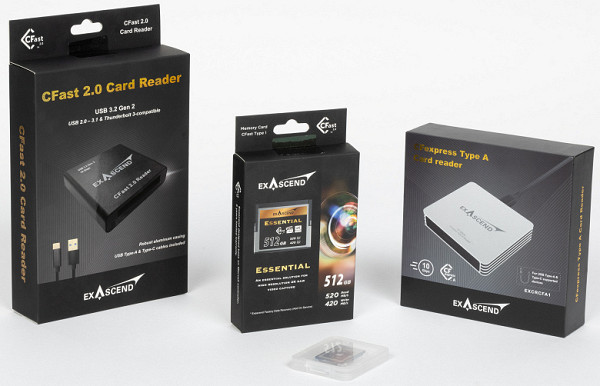
The history of memory card formats, starting with CompactFlash, has developed ambiguously. In 2011, the XQD format appeared, which could not gain a strong foothold in the market due to the limited bandwidth of the first version of PCIe Gen2, which even put it at a disadvantage compared to SATA600 and the CFast 2.0 format. However, in 2014, XQD was improved with the addition of a second PCIe Gen2 lane, increasing throughput to up to gigabytes per second. Despite this, developers were divided into two camps, which made it difficult to promote the standard.
While professional tech continued to use the old CompactFlash cards, some users switched to compact SD cards, increasing speeds to 312 MB/s in 2014. This was sufficient for everyday use, despite the higher performance of the CFast and XQD formats.
Ultimately, the CompactFlash associations came together to develop a new standard, CFexpress, in 2017. CFexpress is based on XQD, but has moved to two PCIe Gen3 lanes, increasing bandwidth to 2 GB/s. This format remains fully compatible with XQD technology, requiring only a firmware update. In 2019, 2.0 specifications appeared, including three physical card formats: Type B for XQD / CFexpress 1.0, Type A with reduced dimensions and one PCIe lane, and Type C with four PCIe lanes providing speeds up to 4 GB/s and in the future up to 8 GB/s with the transition to PCIe Gen4.
These changes make CFexpress a very promising standard that can meet the high data transfer needs of today's professional and semi-professional devices.

Unfortunately, the latter format will likely remain a niche product. It could be an excellent alternative to external SSDs, given their compact size. Compact Type A cards are already supported by some Sony cameras, but the alternative SDexpress format has not yet found widespread support and has its own objective disadvantages.
CFexpress also has disadvantages — combining incompatible cards into one standard does not guarantee full compatibility. Perhaps in the future Type B will give way to the compact Type A, as its popularity is currently maintained mainly due to its XQD compatibility. Type A, although it will be half as fast as Type B, will be able to evolve and reach the required speed when equipment manufacturers need it.
Exascend, although young (founded in 2016), already offers high-speed microSDXC up to a terabyte in its product range, but its main focus is on professional solutions for photographers and videographers.
Exascend Essential CFast 2.0 512 GB
Exascend offers cards with capacities up to a terabyte in its lineup, which is significantly higher than the 128GB maximum we're already familiar with. However, it seems to us that the main factor holding back buyers is not so much the technical as the financial side of the issue. Although flash memory has become significantly cheaper in recent years, it is still not given away for free :) We deliberately chose a card with less than the maximum capacity, since this allows us to maintain a higher write speed.

The dimensions of cards with a serial interface remain the same as in the days of the parallel interface: 42x36x3.3 mm. The only difference was the connector: a pin connector with 50 contacts, which often bent and broke when the card was skewed, was replaced with a knife connector. The new connector uses 7 pins for the interface, typical of SATA, and 17 pins for power (although they are slightly different from SATA). This is practically a hot-swappable SATA SSD — which is what made CFast so popular among manufacturers of not only cameras, but also industrial equipment.
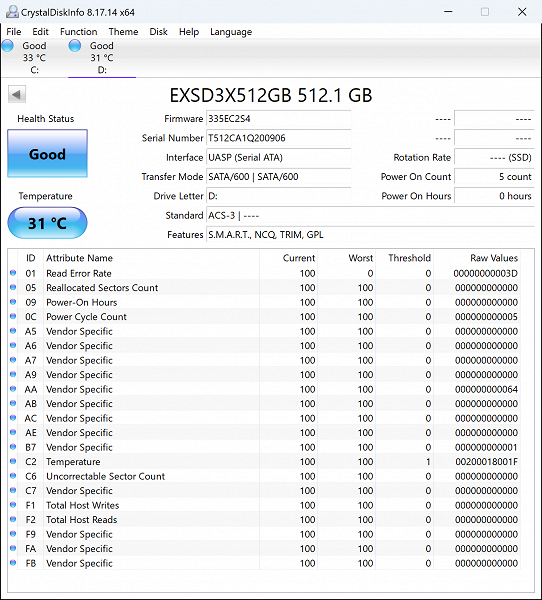
Sincerely speaking, it is difficult for us to imagine how events would have developed if CFast had appeared not in 2008, but much earlier, for example, in 2003. By 2008, it was already a little late: SATA, initially a promising interface, began to lose its relevance. Of course, it was clear that SATA would be used for a long time, but the potential for further modernization was already limited. Instead, manufacturers chose to extend the life of CompactFlash, which seemed reasonable at the time, but later led to problems.
Exascend Essential CFexpress Type A 480 GB
The company has already announced the upcoming release of CFexpress 4.0 Type A cards, but at the moment there are no compatible connectors to connect them. Once the need arises, these cards will be able to achieve the same speeds that are formally required for Type B cards, although these capabilities have not yet been actually used. However, CFexpress 4.0 cards will be compatible with equipment that supports previous versions of the standard, but will not speed up its operation.
Therefore, we decided to go with an older type of card. I must say that the format amazed us. The only practical alternative is SDexpress, but can the plastic housings of the latter compare with the durable and noble metal of CFexpress? We think not. In addition, CFexpress connectors are simpler: SD cards require two rows of contacts for PCIe x1 and three rows for x2, while CFexpress makes do with just one. Perhaps this is why manufacturers are in no hurry to introduce SDexpress — they have a compact and technologically advanced alternative. If the CFexpress format becomes widespread, we wouldn't be surprised to see it supported by laptop manufacturers, providing users with a fast and convenient removable storage medium comparable in speed to external USB SSDs, but in a more compact design. However, making forecasts in modern conditions is always a thankless task. It has happened more than once that technically excellent developments remained unclaimed, while less advanced solutions conquered the market (just remember the history of the USB interface).
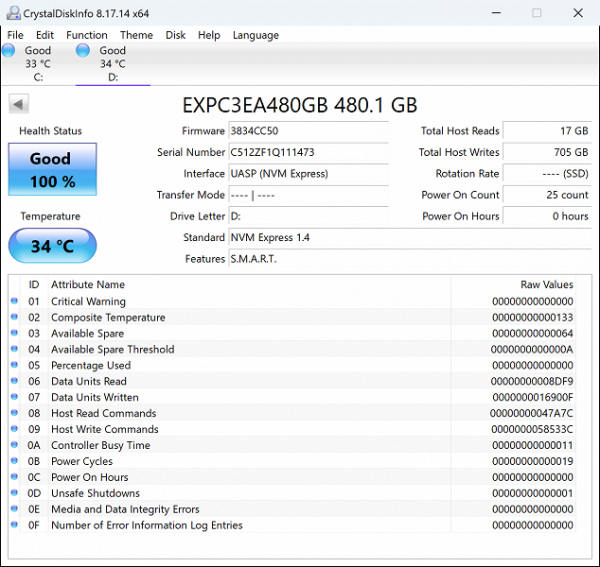
So, we will focus on the fact that the cards are already available, and the equipment corresponding to them is also available, although in limited quantities. This is already more than can be said about SDexpress. In addition, these cards can be connected to a computer, which allows you to evaluate their speed characteristics. This is exactly what we will do.
Map guides
In principle, CFast cards can be connected to a desktop computer directly using adapters to connect to a SATA port, and CFexpress can be installed in a PCIe slot. However, desktop computers no longer occupy as large a segment of the computer market as they once did, as many photographers and videographers prefer to use laptops due to the need to work in the field. So far, built-in support for new card formats has not appeared in laptops, and SD slots have almost disappeared from mass models, which puts all cards on an equal footing. However, the USB situation has improved significantly over the past 20 years, with fast versions of USB 3.2 Gen2 now standard on modern laptops. To use all the features of the new cards, just one USB port is enough, which makes them accessible and convenient to use.
CFast card models are very similar to standard CompactFlash card readers; the changes here mainly concern only the connector. These cards are even easier to manufacture compared to the CF versions, which required specialized USB bridges to support UDMA7 mode, which is not standard for computer drives. CFast makes do with a regular USB-SATA bridge, which has long become a standard component of technology. In the past, there may have been compatibility issues such as the inability to view SMART, Trim support, etc., but modern firmware updates solve this problem.
It was not possible to determine the specific bridge in this case, but, we repeat, this can still only be done out of love for art, since these are not exclusive specific chips at all. The main thing that is required of them is support for SATA600 and USB3 Gen2 (Gen2 is a little redundant for SATA600, but Gen1 itself would limit the speed). Until recently, a huge number of external SSDs were built on this same basis. Budget models even now have not moved away from this scheme, but in their case, performance is still determined not by the bridge, but by the internal SATA SSD itself “soldered” to it. CFast cards are just a compact version of such devices, optimized for frequent hot-swapping and re-plugging.
CFexpress occupies the same niche as NVMe SSDs, but in the form of external removable media. The number of PCIe lanes is limited to two (for XQD / Type B) or one (for Type A), which simplifies the development of card readers. For Type A cards, USB3 Gen2 is sufficient, which would already limit the speed of Type B cards. In this case, JMicron JM583 is used — a universal USB bridge that supports Gen2 and remains relevant in conditions where high speeds are not required.
Structurally, this card reader is similar to the previous one, although CFexpress cards are more compact. However, the importance of reducing the size of the reader is no longer important, since the focus is on high-speed recording performed by a photo or video camera in real-world use cases.
The card reader is actually an external SSD with a USB interface, so it can be used for testing in this capacity. This will allow us to understand how it works and compare it with already familiar devices of a similar design.
Testing
Samples for comparison
We chose two external SSDs from WD — the SanDisk Extreme Portable, which is no longer in production, and the WD My Passport, which is also not new. Why them? These models represent original standards of two concepts: USB-SATA (in the case of SanDisk Extreme Portable) and USB-NVMe with an interface up to 10 Gbps (for WD My Passport). The first corresponds to CFast in the card reader, while the second is slightly superior to CFexpress Type A thanks to two PCIe Gen3 lanes in typical USB-NVMe bridges, which fully utilizes the capabilities of the external interface, unlike CFexpress Type A, which lacks one lane. However, we are more interested in not only quantitative, but also qualitative characteristics. First of all, this is the stability of quantitative characteristics, especially the speed of streaming recording, which is critically important in digital photo and video equipment. In this regard, “reference” SSDs perform well, but we are also interested in studying the cards. One important thing to note is that both external SSDs from WD are 1TB in capacity, while the CFexpress cards we're reviewing are half that capacity. This creates additional challenges, but this approach is normal given the differences in device types.
Filling with data

Let us repeat once again that the sequential recording schedule of the SanDisk Extreme Portable is almost standard — we clearly rely on the SATA interface. You can't jump over your head.
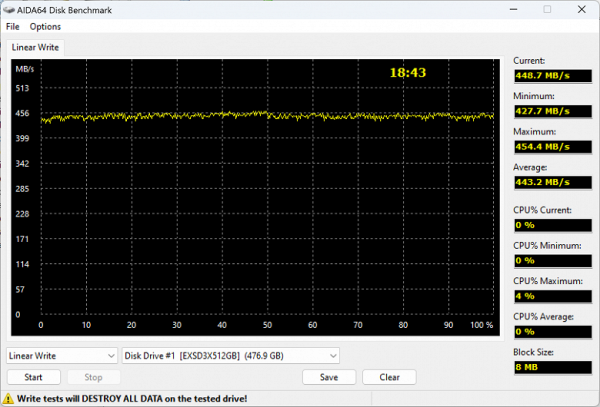
The CFast head remains at the same level — SATA600. The speed in this case turned out to be slightly lower, but it should be taken into account that the card capacity is also less, which plays a significant role. In fact, SATA SSDs with a capacity of about half a terabyte, capable of reaching best values of up to 300 MB/s when writing outside the cache, were widely used four to five years ago, but then began to gradually disappear. WD updated its Blue models, Crucial released a new version of the MX500, and Samsung replaced the 850 Evo with the 860 Evo. In all of these cases, including others not mentioned, the updated half-terabyte SSDs began to show out-of-cache write speeds of around 300 MB/s. The Exascend Essential CFast 2.0 card is capable of reaching approximately 450 MB/s — in the context of technology where such cards are used, this is more than enough with a large margin.
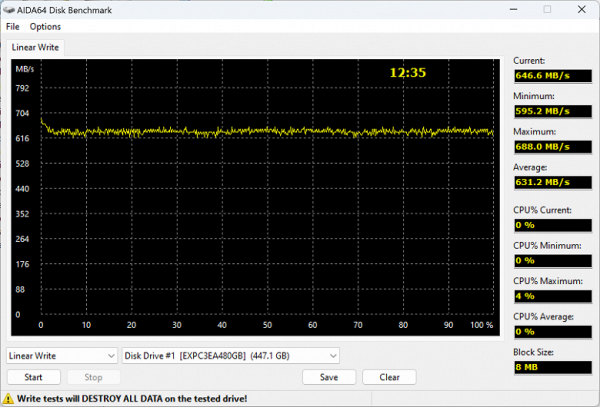
Photo and video technology is gradually developing, and the needs are growing. CFast proved to be unscalable and stalled due to its limited architecture. On the other hand, CFexpress Type B is too expensive and redundant for many cases. That's why CFexpress Type A was invented, which immediately adapted to the new requirements. When the transition to PCIe Gen4 occurs (Exascend has already announced similar cards, although there is no real need for them yet), the speed will double, opening up new possibilities.
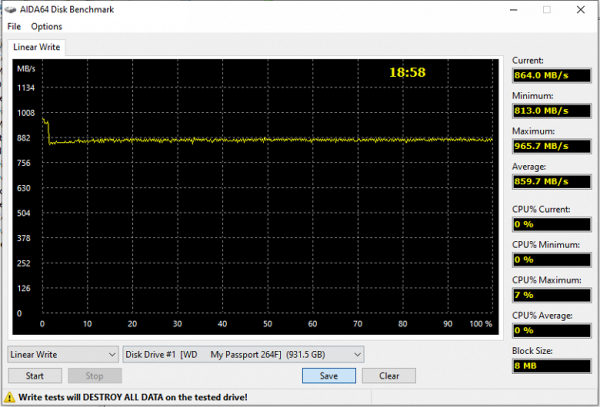
Despite its «benchmark» status, WD My Passport uses the entire available front-end interface within just a small SLC cache, achieving speeds of up to 850 MB/s on a small amount of data. This terabyte drive belongs to older models, where half-terabyte versions contained 500 GB. Successors like the WD Blue SN550 are even slower in such conditions. However, memory cards are not as tolerant of such limitations, so manufacturers strive to extract maximum performance from them without regard to capacity. The 480GB cards are easily comparable to the best higher-capacity consumer SSDs, achieving speeds of just over 600MB/s despite the slight speed penalty caused by the bridge in the card reader.
Working with large files

Fast sequential reading can be important for users who need to quickly transfer pictures from the camera to the computer. CFexpress cards perform well in these conditions — they are often even faster than external SSDs when all things are equal. In situations where the playing field is not equal due to the use of one PCIe lane instead of two, performance may be slightly reduced, but in the context of the card market this is already progress. Looking ahead, moving from PCIe Gen3 to Gen4 will allow for even greater speed increases, although this will require new card readers, including those that support faster external interfaces.
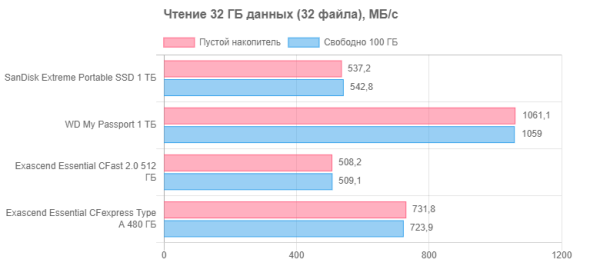
Multi-threaded mode for the intended use of memory cards is unlikely to be useful in practice, so it makes sense to look at the results only to improve general education and comparison.
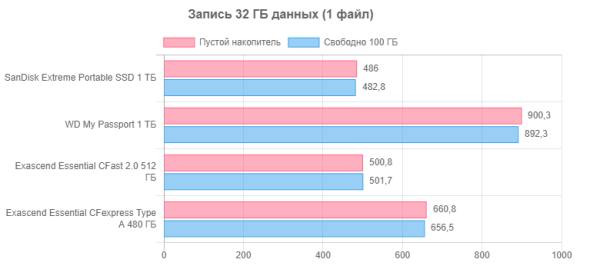
This scenario is key from a practical point of view. However, its predictability is palpable. Updating the CFexpress card interface was necessary to enable further growth — the technology itself lags a little behind at every stage of development. The developers also took the opportunity to make the media more compact and simplify the connectors — and this move turned out to be the right one.
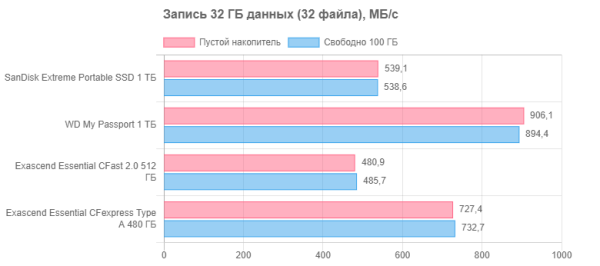
For basic applications, the synthetic script is not always applicable. As already noted, industrial equipment manufacturers have fallen in love with the CFast format, where these cards are used as the main and only drive. In such conditions, the performance requirements are usually not very high. However, the idea of switching to CFexpress Type A has its attractive sides — not so much an increase in speeds, but a simplification of the design. The SATA standard is on its last legs (in a global sense — it will not disappear tomorrow, but there is no point in clinging to it for a long time), while PCIe is more universal, and there are already compact and convenient removable media oriented towards it.
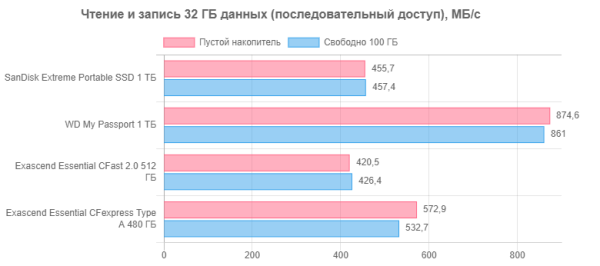
It is clear that no one has optimized the card firmware for such scenarios (and for multi-threading in general), so there is nothing to amaze us with. However, this is not required — it is enough to ensure stable performance, which exists even with low modern capacity standards.
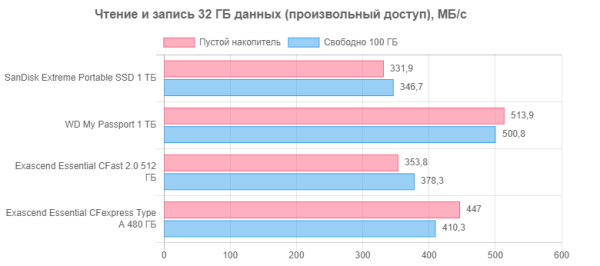
Another comparison for purely illustrative purposes. But the conclusions are the same as in the previous case. No one specifically optimizes cards for such scenarios, but this is not required — by design they guarantee stable performance. High write speeds, which are achieved without excessive caching, distinguish these cards from mass-produced budget flash drives. Reading delays also do not cause problems for them. So there is no special optimization and is not required.
Comprehensive performance
Currently, the best comprehensive storage benchmark is PCMark 10 Storage. In our review, we briefly described this tool. We noted that not all three tests included in the kit are equally useful. The most informative test turned out to be the «Full System Drive» test, which covers almost all common usage scenarios, including loading the operating system and copying data (both internal and external). The other two tests are only partial subsets of «Full System Drive» and, in our opinion, are less interesting.
The «Full System Drive» test is useful because it accurately measures not only the actual throughput when solving practical problems, but also the resulting latencies. Averaging metrics over different scenarios and reducing them to a single number is, of course, synthetic, but it allows us to obtain estimates that are closer to reality in general, and not just in particular cases. At the moment, this approach is most suitable for comparing various drives, including not only “full-format” and low-budget external SSDs, but also memory cards, although for the latter it may be redundant.

Let me emphasize once again that memory card firmware is not specifically optimized for tasks that require fast access or high bandwidth. Nevertheless, even in such conditions the cards demonstrate decent results. For example, CFast cards that are used in industrial equipment are usually connected directly via the SATA interface, which allows them to achieve high speeds. However, even through the USB interface their speeds remain quite acceptable.
CFast and CFexpress cards are based on the same SSDs as in any other devices — they are simply made in a specific form factor and meet the specific requirements of consumers.
Bottom line
The results and the cards themselves cause regret that they can no longer claim to be universal computer drives in modern conditions. Once upon a time, good old CompactFlash could be used with any laptop thanks to the presence of PCMCIA slots almost everywhere. However, at that time, flash memory was too expensive for such use, and as the cost dropped, USB flash drives, hard drives with this interface, and external SSDs came to the fore, which could easily be created from any internal drive by adding a USB bridge.
Today we should no longer expect “innate” support for such card formats in modern mass-produced computers, which is an omission. External SSDs become a necessary compromise: CFexpress cards are compact, convenient and reasonably fast, and CFast would satisfy many users, given how inexpensive external or internal SSDs sometimes perform.
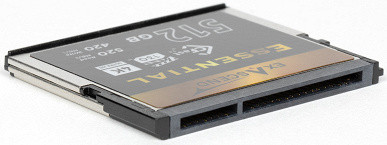
On the other hand, in the hypothetical scenario described above, price competition will begin, which effectively jeopardizes SATA SSDs. When price becomes the main driver of «progress», regression occurs in other areas. There are a lot of slow (or very slow) external SSDs on the market, and sometimes it’s hard to look at mass-produced flash drives without crying. Buyers strive to find cheaper options — and often find them, albeit at their own peril and risk.
However, such tricks do not work with cards. This is especially true for the successors of CompactFlash, intended for “serious” equipment, like their predecessors. Unlike CompactFlash, which 20-25 years ago were sometimes used in “frivolous” equipment such as point-and-shoot cameras, PDAs and MP3 players, CFexpress is not particularly needed here, given the presence of microSD.
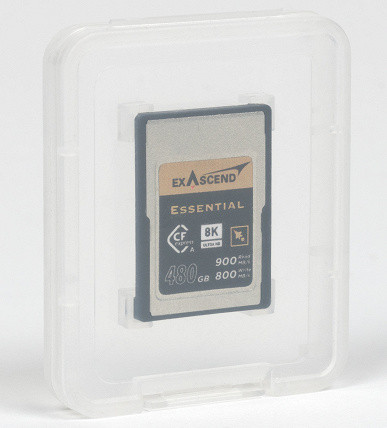
Every coin has two sides. Today, the memory card market has become quite predictable, as has the process of choosing the appropriate format for the equipment used. If you have an old but still functional camera with CompactFlash, then this format remains relevant for such a device. If you have a device that uses CFast, then CFast should be selected. If you have a Sony A1 that supports CFexpress Type A and Secure Digital UHS-II (which ensures compatibility), but with a ceiling of 312 MB/s (less than CFast), you should choose CFexpress Type A. Although it is possible to use SD UHS cards -II, but they can limit the camera's capabilities if they are not suitable for speed.
The CFexpress format is more predictable due to its specialization. Manufacturers know exactly what is required of such cards and meet these requirements. In practice, the standards are consistent, which is reflected in Exascend's cards. It is important that CFexpress offers a high constant write speed, which is necessary for such devices, while for “computer” SSDs such speed may be excessive and not optimized.
Thus, the choice of memory card depends on the specific needs of your equipment, and CFexpress Type A is a promising choice due to its performance and specialization for modern equipment.

